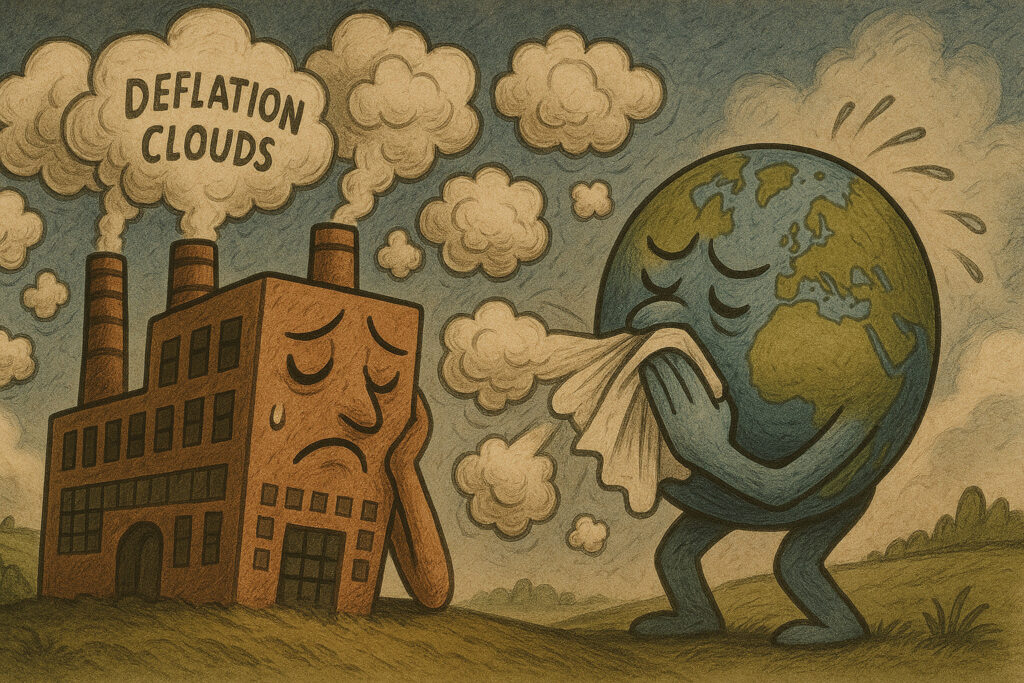Introduction
China’s producer prices fell for the 19th consecutive month in June 2025, intensifying global concerns over deflationary pressures in the world’s second-largest economy. According to data released on July 8 by the National Bureau of Statistics (NBS), the Producer Price Index (PPI) declined by 2.7% year-over-year, exceeding market expectations of a 2.3% drop and deepening May’s 2.1% contraction.
The persistent slump in factory-gate prices reflects ongoing weakness in China’s industrial sector, sluggish domestic demand, and subdued global trade dynamics. It also underscores the challenges Beijing faces in attempting to stimulate growth without reigniting financial imbalances. At the same time, China’s Consumer Price Index (CPI) remained barely positive at +0.3% year-over-year, fueling debate over the effectiveness of current fiscal and monetary tools.
Markets across Asia responded negatively to the report, while global commodities and risk assets reeled from implications of diminished Chinese demand. This article unpacks the data, assesses market and policy reactions, and examines the broader global ramifications.
PPI Breakdown: Decline Deepens
The 2.7% year-over-year drop in June PPI represents the sharpest deflation in factory-gate prices since November 2023. Major contributors to the decline included:
- Raw materials and mining: -4.1% YoY
- Ferrous metal smelting and processing: -5.2% YoY
- Petroleum and coal processing: -3.6% YoY
- Chemical manufacturing: -2.8% YoY
The PPI data highlight deteriorating pricing power for industrial producers, many of whom continue to operate below capacity due to weak export orders and fragile domestic consumption.
CPI Stalls: Consumer Demand Lacks Traction
The CPI rose just 0.3% year-over-year in June, missing expectations of a 0.5% rise and matching May’s print. Core inflation, which strips out volatile food and energy prices, remained at 0.4%, suggesting limited underlying price momentum.
Food prices were flat year-over-year, while services inflation slowed further. This stagnation in consumer price growth reflects cautious household spending and elevated savings rates amid labor market uncertainty and a cooling property sector.
Market Reactions: Equities and Commodities Retreat
Asian equity markets responded to the deflationary signal with losses:
- Shanghai Composite: -0.8%
- Hang Seng Index: -1.3%
- CSI 300: -1.1%
Real estate, industrials, and consumer discretionary stocks led the declines, with tech names also under pressure due to weaker demand outlooks.
Commodities were broadly lower:
- Copper: -1.6% to $4.29 per pound
- Aluminum: -0.9%
- Iron ore: -2.2% on Chinese exchanges
The reaction in metals markets underscores expectations for further demand softness in construction and manufacturing.
Global Spillovers: Risk Aversion Increases
The deflationary signal from China reverberated across global markets:
- European equities opened lower, with the Euro Stoxx 50 down 0.6%
- U.S. equity futures edged lower in pre-market trading
- The MSCI Emerging Markets Index fell 0.7% on the day
Safe-haven assets rallied:
- Gold: +0.6% to $2,513 per ounce
- U.S. 10-year Treasury yield: Down 3 bps to 4.15%
- Japanese yen: Strengthened to 158.92 per dollar
Investors recalibrated expectations for global demand and inflation, reinforcing dovish central bank outlooks in developed markets.
Policy Response: Beijing Cautious, But Pressure Rising
The PBoC has thus far resisted large-scale stimulus, opting instead for targeted credit easing and liquidity injections. The central bank maintained its medium-term lending facility (MLF) rate at 2.5% last month but hinted at potential reserve requirement ratio (RRR) cuts.
Fiscal tools have focused on local infrastructure projects and support for small- and medium-sized enterprises (SMEs), though local government debt constraints remain a limiting factor.
The market is increasingly calling for:
- Broader monetary easing, including a rate cut in Q3
- Property sector stabilization measures
- Expanded consumer stimulus to spur demand
Yet Chinese policymakers remain wary of financial instability, particularly in the shadow banking and real estate sectors.
International Context: Global Disinflation Tailwind
China’s deflation is increasingly being viewed as a global disinflationary force. Cheaper Chinese exports could suppress prices worldwide, aiding central banks in their inflation fight. However, persistent deflation raises concerns about global growth.
Key implications include:
- Fed and ECB may gain more room to cut rates as global price pressures ease
- Emerging markets face risks from weaker Chinese demand, especially commodity exporters
- Multinationals reliant on China could revise earnings guidance downward
Conclusion
China’s deepening PPI decline and stagnating CPI point to entrenched deflationary pressures and highlight the country’s struggle to engineer a sustainable recovery. The data released on July 8 reaffirm the view that the industrial engine of China remains under significant stress, with demand-side support proving insufficient thus far.
Markets reacted with caution, pulling back from risk assets and rotating into safe havens. Commodities and Asian equities bore the brunt of selling, while expectations for additional policy support from Beijing are building.
Looking ahead, investors will monitor:
- Upcoming Chinese credit and trade data for July
- The PBoC’s next policy moves, especially any RRR or benchmark rate adjustments
- Q2 earnings from industrial and commodity-linked firms globally
As China’s deflationary trends deepen, the global market narrative may increasingly shift from inflation-fighting to growth-stabilization—adding complexity to policy responses across both emerging and developed economies.
